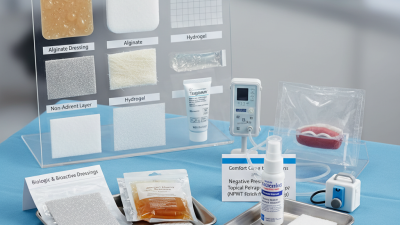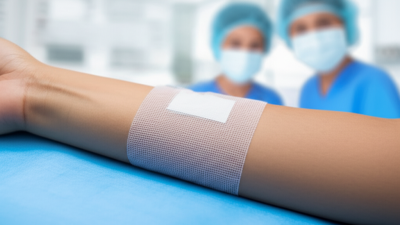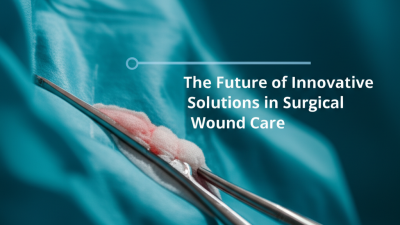Top 10 Surgical Wound Dressing Solutions for Faster Healing and Comfort
In the realm of healthcare, the significance of effective surgical wound dressing cannot be overstated. As Dr. Emily Carter, a renowned expert in wound management, aptly stated, "The right surgical wound dressing can not only accelerate healing but also significantly enhance patient comfort." With the myriad of options available, identifying the most suitable dressing can sometimes be overwhelming for both healthcare professionals and patients alike.

The advancements in surgical wound dressing technologies have led to innovative solutions that cater to diverse needs, from promoting optimal moisture levels to providing antimicrobial protection. In this guide, we explore the top ten surgical wound dressing solutions that stand out for their effectiveness and comfort. These carefully curated options aim to address the complexities of wound healing, helping to ensure speedy recovery and a better quality of life for patients. By understanding the benefits of each dressing type, caregivers can make informed decisions that contribute to positive healing outcomes.
Understanding the Importance of Surgical Wound Dressings for Optimal Recovery
Surgical wound dressings play a vital role in ensuring optimal recovery following surgical procedures. They not only serve to protect the wound from infection but also provide essential support for faster healing. Recent advancements in perioperative care, particularly the Enhanced Recovery After Surgery (ERAS) guidelines, emphasize a patient-centered approach that improves outcomes by reducing surgical stress. Modifying the way wounds are dressed can directly impact the recovery trajectory, alleviating pain and enhancing comfort during the crucial healing process.
Leading manufacturers of wound closure products are continuously innovating, incorporating advanced materials and technologies designed for improved safety and efficiency. By focusing on factors such as moisture management and antimicrobial properties, these solutions not only speed up healing times but also lower the risk of complications. Coupled with the right nutrition and rehabilitation services, these dressing techniques can significantly enhance the overall recovery experience for patients, enabling them to regain independence and return to their normal lives more effectively.
Top 10 Surgical Wound Dressing Solutions for Faster Healing and Comfort
Choosing the Right Dressings Based on Wound Type and Healing Stage
When it comes to optimizing wound care, selecting the appropriate dressing is crucial and must be tailored to the wound type and healing stage. For acute wounds, such as surgical incisions, dressings that provide moisture balance are essential. Hydrogels and foam dressings help promote a moist environment, which is vital for tissue regeneration and reduces the risk of scabbing, ultimately facilitating faster healing. In contrast, for wounds prone to infection or with significant exudate, antimicrobial dressings or alginates may be a better choice. These materials not only absorb excess fluid but also help prevent bacterial colonization.
As wounds progress into different healing stages, the choice of dressing should evolve as well. For granulating wounds, breathable film dressings can protect the healing tissue while maintaining moisture and allowing gaseous exchange. Once a wound enters the remodeling phase, lighter dressings that minimize occlusion may be preferred to prevent irritation and promote skin elasticity. By understanding the specific requirements at each stage of healing, healthcare providers can significantly enhance patient comfort and improve outcomes, ensuring the best possible recovery experience.
Key Features to Look for in Advanced Wound Dressing Materials
When selecting advanced wound dressing materials, several key features stand out that can significantly impact healing and patient comfort.
One primary feature is the material's moisture management capability. A study by the Wound Healing Society reported that maintaining a balanced moisture level can accelerate healing by up to 50%.
Dressings that are either too dry or too wet can hinder the natural healing process, making the choice of materials critical.
Another important characteristic is biocompatibility.
Advanced wound dressings should be hypoallergenic and cause minimal irritation to the surrounding tissue.
According to research published in the Journal of Wound Care, dressings with low friction and high elasticity can reduce pain during dressing changes and improve overall patient satisfaction.
Furthermore, antimicrobial properties are essential, as evidenced by a systematic review where dressings with antimicrobial agents reduced infection rates by approximately 30%.
These findings underscore the importance of selecting wound dressings that not only provide physical protection but also promote a healing environment.
Tips for Proper Application and Maintenance of Surgical Dressings
Proper application and maintenance of surgical dressings are crucial for promoting healing and preventing infections. According to a report by the World Health Organization, about 11% of surgical patients experience wound infections, which can significantly delay recovery. To mitigate these risks, it’s essential to ensure that the dressing is applied correctly. First, the wound area should be cleaned thoroughly with saline or antiseptic solution to minimize bacterial load. Next, the dressing should be applied in a manner that secures it without applying excessive pressure that could impede blood circulation, which is vital for healing.
Maintenance of surgical dressings should involve regular monitoring for signs of infection such as increased redness, swelling, or discharge. The Centers for Disease Control and Prevention recommends changing the dressing at least once a day or as needed based on the condition of the wound. For optimal outcomes, healthcare professionals suggest using advanced wound dressings, such as hydrogels or foam dressings, that provide moisture balance and enhance comfort. A study published in the Journal of Wound Care found that wounds managed with these advanced dressings heal 30% faster than those with traditional gauze, highlighting the importance of both application techniques and dressing selection in surgical wound care.
Exploring Innovative Technologies in Wound Dressings for Enhanced Comfort
Innovative technologies in wound dressings have revolutionized the way we approach surgical healing. Modern dressings are designed not only to protect the wound but also to create an optimal healing environment. Advanced materials, such as hydrocolloids and alginates, are commonly used to maintain moisture levels while allowing for gas exchange, which can significantly enhance the healing process. Furthermore, some dressings now incorporate antimicrobial agents to prevent infection, ensuring that patients experience less post-operative discomfort.
Tip: When choosing a wound dressing, prioritize those with moisture-retentive properties. This will help reduce the risk of scab formation, allowing for a more comfortable and faster healing experience.
In addition to materials, the integration of smart technologies is making waves in wound care. Smart dressings equipped with sensors can monitor various parameters, such as moisture levels and temperature, providing real-time data to healthcare providers. This innovation not only helps in tailoring individualized care but also minimizes discomfort for patients, as their healing can be closely monitored without frequent dressing changes.
Tip: For optimal comfort, consider dressings that are non-adherent and flexible, allowing for greater mobility while minimizing pain during dressing changes.
Top 10 Surgical Wound Dressing Solutions for Faster Healing and Comfort
| Dressing Type | Material | Healing Time (Days) | Comfort Level | Moisture Management |
|---|---|---|---|---|
| Hydrocolloid Dressings | Gel-forming polymers | 7-14 | High | Maintains moisture |
| Foam Dressings | Polyurethane foam | 5-10 | Very High | Absorbs excess moisture |
| Alginate Dressings | Seaweed derivatives | 7-14 | Moderate | Highly absorbent |
| Hydrogel Dressings | Water-based gels | 5-12 | High | Provides moisture |
| Composite Dressings | Multiple layers | 9-15 | Very High | Optimized for fluid management |
| Silicone Dressings | Silicone polymers | 7-10 | Excellent | Adhesive yet gentle |
| Transparent Films | Polymer films | 3-7 | Moderate | Allows vapor exchange |
| Collagen Dressings | Animal-derived collagen | 8-14 | High | Supports cell growth |
| Negative Pressure Wound Therapy | Specialized systems | 10-21 | Very High | Removes excess fluid |
| Antimicrobial Dressings | Active agents like silver | 7-14 | High | Prevents infection |
Related Posts
-

Unlocking Global Opportunities in Wound Care Management at the 137th Canton Fair 2025
-

2025 Innovations in Wound Care Management: Unveiling Effective Strategies for Global Buyers
-

Understanding the Importance of Surgical Wound Dressing in Modern Healthcare
-

How to Choose the Right Wound Dressing for Effective Healing Solutions
-

Ultimate Guide to Selecting the Best Wound Care Products for Global Buyers
-

The Future of Innovative Solutions in Surgical Wound Care
